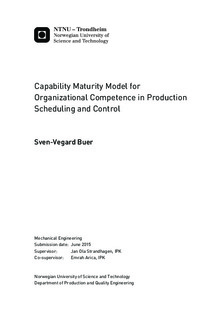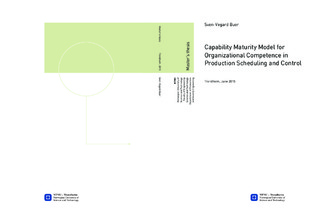| dc.description.abstract | Literature on production planning and control has focused almost exclusively on technical aspects, addressing the development and implementation of new or existing analytical models for different types of production environments. Recent studies have however shown that organizational factors have a significant impact on the production planning and control performance. The aim of this study has been to develop a capability maturity model that evaluates an organization s ability to take into account the organizational factors in performing the production scheduling and control process. This study advances the understanding of how organizational factors influences production scheduling and control. This study is motivated by two research questions: (1) How to evaluate the organizational competence in production scheduling and control? (2) What is the current level of organizational competence for production scheduling and control in a selected case company? To answer these questions, the study utilized a qualitative literature study to examine organizational factors discussed in literature. The capability maturity model is based on these findings and on the organizational maturity levels defined in ISO/IEC 15504-7:2008. In order to test out the model, a case study at the pipe manufacturer Pipelife Surnadal was conducted.
The findings from this research show that organizational factors have a significant impact on production scheduling and control performance. Organizational factors should therefore not be overlooked. Nine organizational factors of production scheduling and control were identified in this study: 1) decision autonomy between shop floor and schedulers, 2) department structure and scheduler location, 3) scheduler training, 4) knowledge and communication facilitation of scheduling interconnections, 5) collaboration during rescheduling, 6) common understanding of problems and constraints, 7) fit between context and scheduling and control systems, 8) synchronization of performance indicators, and 9) reduction of compensation tasks.
The capability maturity model for organizational competence in production scheduling and control evaluates scheduling environments on a five-level maturity scale. The model specifies characteristics and criteria for each level, which make it easy for an environment to evaluate itself and get suggestions for improvement.
By using the developed model, the organizational competence of Pipelife Surnadal s scheduling and control function was evaluated. The theory-testing and evaluating case study showed that the model is well fitted for real life situations, and identified some organizational aspects that they should focus on in order to improve their scheduling and control performance.
The findings in this report support the idea that organizational factors have an influence on production scheduling and control performance. This study presents a number of relevant organizational factors, and introduces a model that helps scheduling and control environments to evaluate themselves and get improvement suggestions regarding handling organizational factors. | |

